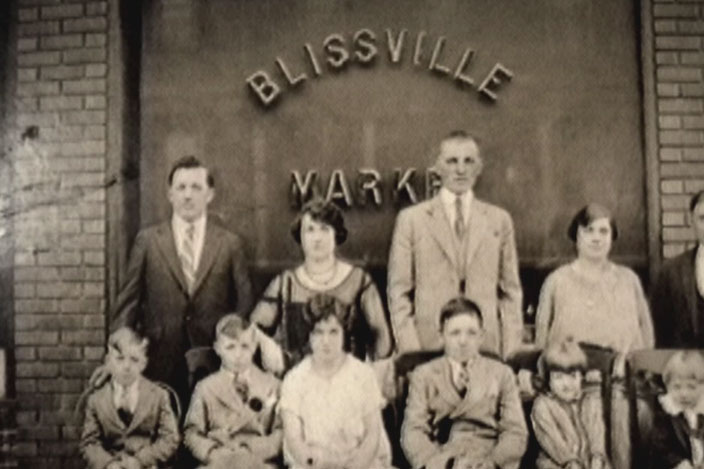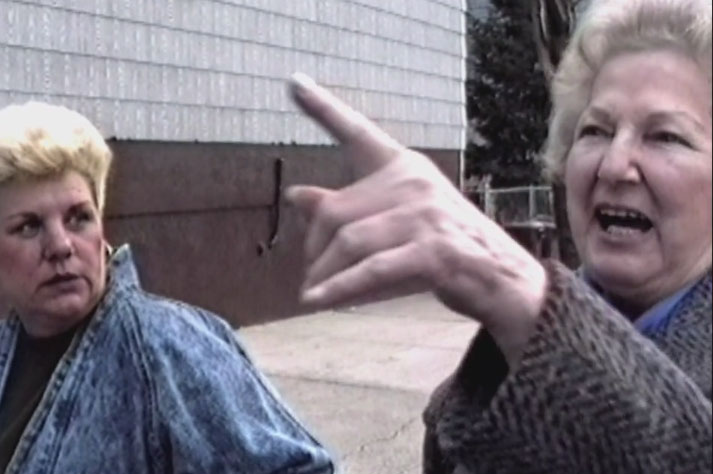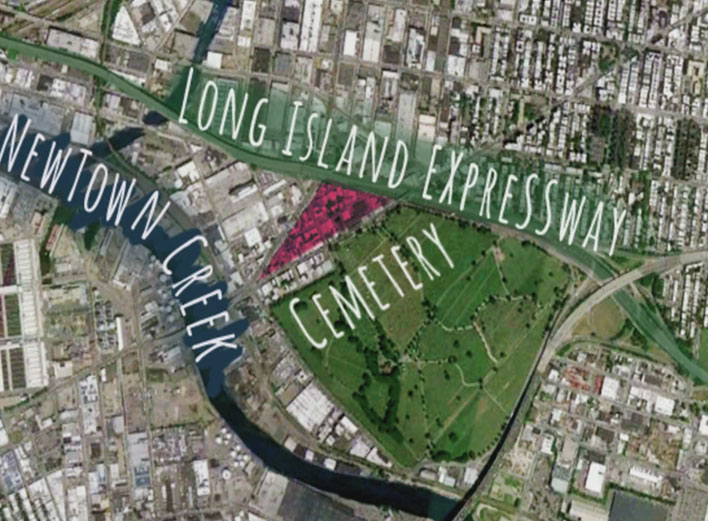Brooklyn-based artist Hank Linhart stumbled upon a Queens neighborhood in the late 1980s that continues to fascinate him today.
Twelve years and 160 hours of raw footage later, Linhart’s docu-poem “Blissville…An Investigation” explores the neighborhood’s history through a series of interviews and footage captured from 1989 through 2017.
“I went over the Greenpoint Avenue bridge one day and just found this little pocket of a neighborhood and it felt so isolated and peculiar in its isolation,” he said. “I saw a woman in the [Calvary] Cemetery picking fruit from a tree and eating, and I was curious to talk to her. She ran away.”
But Linhart didn’t give up on the neighborhood, which is technically in Long Island City and bordered by the cemetery, Newtown Creek and the Long Island Expressway. He visited a local deli and saw a photo hanging up on the wall of a store called Blissville Market. He learned from the owner that the building used to be the deli in the 1930s.
The name intrigued him and Linhart set out to find out more about the neighborhood.
“I was like, ‘Wow, the name Blissville. Why did they name it that?'” he said. “I started to explore and found these kind of interesting industries there.”
From 1989 to 1996, Linhart visited the neighborhood constantly, speaking to residents about its history. He found that the neighborhood was home to the largest fortune cookie factory, a factory that owned the exclusive rights to make replicate figures of the State of Liberty, a sushi factory and an Afghan bakery.
The different industries also attracted a variety of people from different countries such as China, Japan, countries in South America and eastern European countries.
“That really attracted me to the whole thing, there was a mix of ethnic groups and nationalities that was just kind of astonishing to me,” he said.
The neighborhood has a long industrial history. Neziah Bliss, an inventor and shipbuilder who owned most of the land in the mid-1800s, founded Novelty Iron Works, a company that supplied steamboat engines. He completed much of his work in Greenpoint but also was responsible for building a turnpike to connect Brooklyn and Queens.
“Blissville…An Investigation” is split into 10 chapters, and the beginning of the project details the neighborhood’s fascinating history in the 1930s.
“Two women came out of their houses when I was taking pictures of a church on Review Avenue,” he said. “They said, ‘That’s the church where the Gypsy got married. They told me about the Gypsy village. It was the largest settlement of Gypsies in the country. More than 2,000 people lived there in the 1930s.”
Linhart did extensive research and found that Romani, also known as Gypsies, settled in Blissville and created their own shantytown in the area. He even managed to track down a woman in Williamsburg who had lived in the makeshift homes in the Roma village with her family.
“I admire that they [lived through the] depression and they built a village,” he said. “I think it’s amazing that they put this together.”
When Robert Moses was building structures for the 1939 World’s Fair, he built a roadway that cut through the village, which was referred to as the Gypsy Ellis Island, essentially destroying it.
“I show that there’s lots of movement to close the village because of sanitation and all sorts of things,” he said. “It just seemed clear they didn’t want to see Gypsies on the way to the World’s Fair.”
For seven years, Linhart visited the neighborhood and interviewed residents, amassing hours and hours of film. But the birth of his daughter and other projects, including a position at the Pratt Institute and an experimental documentary on the deadliest ship disaster in New York City in 1904, pulled him away. Years later, Linhart found himself drawn to Blissville again.
“The whole interruption was about 14 years,” he said. “Around 2012 I said, ‘Let me see if there’s anything there, if this is worth completing.’ I realized I was the only one that saw all these elements. They wouldn’t have the interviews I had.”
Linhart completed more interviews, decided to break down the one-hour film into chapters and spent a lot of time choosing the music for the project. Though some may be tempted to call this a documentary, Linhart calls his project a docu-poem.
“It has documentary elements but it also has visuals that I just found interesting and sometimes I felt some of those visuals rhymed with other visuals later on in the video,” he said.
The reception from Blissville residents has been warm, he said, and the film had had 47 screenings including in locations in upstate New York, libraries, historical societies and even a state prison in the Adirondacks.
“The state prison screening was incredible because they were prisoners from Queens,” he said. “They were an amazingly attentive audience desperate to see any news about Queens. They were really asking lots of questions.”
The project is popular among Blissville residents who are interested in the neighborhood’s history, especially because of the city’s decision to house homeless families and men in several hotels in the area, Linhart said. The plan has been met with heavy resistance because the number of homeless people will outnumber the amount of Blissville residents once it is finalized.
On April 19, the docu-poem will be screened at the Sunnyside Library at 43-06 Greenpoint Ave. at 6 p.m. followed by a discussion with Linhart. It will also be screened at the Woodside Library at 54-22 Skillman Ave. on April 26 at 6 p.m.
A Brooklyn screening in May will probably be the last for the film, unless others approach Linhart with an opportunity. In the future, he may make the video available to people through DVDs or online through on demand.
In the process of advertising the project, Linhart has created a website that has become more of a community.
“The website is a big part of all of this because it calls for interactions,” he said. “There’s a section called other stories where I ask people to post stories about their own experiences growing up in pictures or videos, their own version of Blissville.”
People from towns all over New York like Nyack, Potsdam, Belfast, Canoga have submitted photos, stories and poems. A former resident of Holmsburg, Pennsylvania, even submitted a short description, video and photos of the town where she grew up.
“I expect to keep that going for a good while,” he said.





































